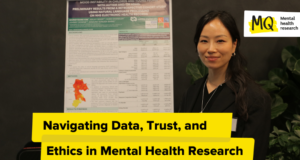
Childhood maltreatment (CM) refers to abuse and neglect that occurs to children and results in actual or potential harm to the child’s health, survival, development or dignity (WHO, 2022). CM is associated with a wide range of adverse outcomes in adolescence and adulthood, including deficits in cognitive development, attention, education, and employment, as well as serious mental health problems, including substance use and addiction problems (Strathearn et al., 2020).
Eating disorders (EDs) are a mental health problem which can be seriously impacted by CM. EDs are centred around disturbances of eating behaviours and a psychopathology focused on food, eating, and body image concerns (Hay et al., 2014). When EDs co-occur with a history of CM, the trajectory tends to be worse (e.g., increased suicidality, increased treatment dropout, and poorer full recovery rates; Molendjik et al., 2017). However, there is a lot we still need to learn in this area.
In their recent study, Eielsen et al., (2023) aimed to contribute to more reliable long-term prognosis of EDs by:
- Examining the prevalence of childhood trauma in a transdiagnostic ED sample
- Identifying the patients’ long-term change trajectories (natural course after an intensive treatment period) over 17 years
- Investigating whether childhood sexual abuse (CSA) and non-sexual childhood trauma predicts class membership.

Childhood maltreatment is common among patients with eating disorders, and is associated with a worse overall trajectory.
Methods
Participants were eligible to take part in the original study if they were aged ≥18 years old with anorexia nervosa (AN), bulimia nervosa (BN), or other specified feeding and eating disorder (OSFED), and had been consecutively admitted to a specialised ED unit in Norway between August 1998 and June 2001. 84 participants provided longitudinal data (mean age = 29.9, SD = 7.5; AN = 30, BN = 37, OSFED = 15, binge eating disorder [BED] = 2), all of whom had received previous treatment for a mean of 3.0 years (SD = 8.0), with over half receiving inpatient treatment (59.5%). However, only 62 participants provided data for the 17-year follow-up, which was when CM was assessed (mean age = 46.2, SD = 7.5).
EDs were measured using the gold standard diagnostic interview, the Eating Disorder Examination interview (EDE; Fairburn, 2008). CM was measured using the Childhood Trauma Questionnaire-Short Form (CTQ-SF; Bernstein & Fink, 1998). CSA was collected retrospectively using official medical records, as well as interview data from each follow-up assessment (1-, 2-, 5-, and 17-year follow-up).
Latent patterns of ED symptom changes were estimated using growth mixture modelling. Prevalence of CM was assessed, with its associated relationship to class membership tested.
Results
Prevalence of childhood trauma
In the 62 participants who completed the 17-year follow-up, childhood maltreatment (CM) was common, with 71% (n = 44) scoring above the clinical cut-off for one or more CM. More than half (58.1%) reported experiencing two or more childhood traumas. Emotional neglect was the most common (n = 31; 50%), while physical neglect was the least common (n = 18; 29%). Over one-in-three (n = 24; 38.7%) experienced childhood sexual abuse (CSA).
Change trajectories of EDs
Four distinct classes were identified:
- Continuous improvement (n = 46; 54.8%): This class continued to demonstrate continuous improvements across the entire follow-up period, reporting scores within the normal range at 17-year follow-up.
- High and declining (n = 19; 22.6%): This class reported high symptom levels at baseline, which moderately decreased over time.
- Consistently low (n = 12; 14.3%): This class had initial ED scores which were below the clinical cut-off at baseline, and this remained stable across follow-up.
- High and increasing (n = 7; 8.3%): This class reported high ED scores at baseline, with significant symptom increase over time.
Childhood maltreatment and group membership
History of CSA was overrepresented in classes with persistently high symptom levels (“high and increasing” = 85.7%; “high and declining” = 57.9%) and was predictive of membership to a class with poorer long-term results. In contrast, non-sexual childhood trauma did not predict group membership.

Eielsen et al. (2023) identified four distinct classes of eating disorder trajectories and their symptoms, with the majority of the sample demonstrating continuous improvement across the 17-year follow-up. However, 1 in 12 demonstrated high and increasing symptoms.
Conclusions
The authors conclude that:
CSA (childhood sexual abuse) significantly lowered the probability of a favourable ED (eating disorder) outcome across decades. This highlights the importance of trauma informed care, as these patients showed little improvement over time.
Trauma informed care is an approach to healthcare that recognises the importance of understanding and responding in appropriate ways to effects of trauma. These results indicate that awareness and delivery of trauma informed care in patients with EDs could improve outcomes for patients with trauma, which highlights this as an urgent next step in research.

Childhood sexual abuse overrepresented in the classes with persistently high eating disorder symptom levels, and predictive of membership to a class with poorer long-term results.
Strengths and limitations
The biggest strength of the present study is that it provides new insight into the long-term trajectories of change for patients with severe and enduring EDs. Prior studies have not been able to provide such a thorough assessment across an extensive time period with numerous timepoints; the current findings have enhanced validity, and also increased generalisability to real-world settings. Furthermore, the authors of this paper assessed CM (childhood maltreatment) in several ways, including a validated questionnaire and past clinical notes to adjust for different kinds of exposure; this is a strength as it again increases the validity and reliability of the results by reducing potential biases associated with each measure and capturing different dimensions for a more holistic understanding. The authors also considered the sensitivity of asking retrospectively about CM and the possibility of negative reactions to these questions and thus administered the CM questionnaire as an interview, also increasing its validity.
However, a limitation of the study is the lack of clear clarification of how CM and childhood trauma were distinguished. While these concepts are related, they are ultimately different, with childhood trauma referring to a broader concept which encompasses abuse and maltreatment, but also loss of a loved one, experiencing accidents and witnessing traumatic events. At times it was not clear in the article what the authors were referring to. Considering the article focussed on CM, it would have made for easier understanding if they only used that terminology throughout their paper, as they only assessed the five subscales which account for CM.
The most critical limitation of the study is the small sample size. The authors acknowledge that the limited sample size violates assumptions for latent class analysis and the reliability of the odds ratios, indicating that a possible superior fit may have been found with more classes and a differently shaped growth curve had the sample size been larger. This means that some of the findings need to be interpreted with caution.
Furthermore, as the authors acknowledge, there is a lack of population representation, with all but one patient being female, and all being White. Research has shown that EDs affect both males and females (Mitchell et al., 2012; Nagata et al., 2019; Thompson, 2022), are prevalent in gender diverse populations (see Sophie’s Mental Elf blog), and are present across cultures (Chen et al., 2022; Hoek, 2016; Pike et al., 2014), and therefore these findings cannot be generalised beyond a specific subpopulation.
However, this exploratory study is a crucial first step in providing indications of long-term trajectories and characteristics related to CM and ED trajectories. In the future, it is important that these results are replicated in a large representative sample to produce definitive results.

This exploratory study is a crucial first step in considering long-term trajectories and characteristics related to childhood maltreatment in patients with eating disorders; but the small sample size and unrepresentative population limit conclusions drawn.
Implications for practice
The authors conclude that trauma informed care in patients with EDs is crucial, with findings from the current study importantly showing that CM (childhood maltreatment) and CSA (childhood sexual abuse) are very prevalent among this group. CSA and child physical abuse have been reported as risk factors for the development of EDs (Caslini et al., 2016; Moulton et al., 2015), with the current study highlighting that CSA in particular is a predictor of poor long-term outcomes for EDs. This highlights the need for a holistic care approach when clinicians are treating patients with EDs, which addresses the physical, emotional, psychological and social aspects of the patient’s well-being. This may include creating a safe environment for the patient, empowering them to feel in control of their recovery, and concurrently delivering therapy for trauma and eating disorders. Healthcare providers should receive trauma-informed training to better understand the links between CM and EDs, including the importance of screening for CM and trauma in this context, and how to best approach care with awareness and sensitivity. This is to ensure that patients aren’t triggered and can develop a sense of trust with their healthcare provider, enabling rapport and a strong therapeutic relationship.
Furthermore, the involvement of a multidisciplinary team (e.g., dietitian, psychologist, treating doctor) is vital for ensuring that a comprehensive care plan is developed that can address both the physical and psychological aspects of the disorder. Personalised treatment approaches, where both the trauma as well as the ED symptoms are addressed concurrently would be encouraged, as research has demonstrated that addressing co-occurring disorders simultaneously is emerging as best practice (Schumm et al., 2016), which could increase the likelihood of positive outcomes for patients with EDs (Wade et al., 2023).
Advocacy for policy and program development that invests in trauma informed care is imperative, to enable the resources that are needed to provide the holistic care to these patients. At the very least, development of trauma informed protocols within health care institutions would help to ensure holistic approach and support of trauma survivors (Sweeney et al., 2016).
While research is starting to focus on the co-occurrence of ED and other psychopathologies, we still need to develop our understanding of the exact links between CM and how it manifests in EDs and poorer long-term outcomes. Therefore, more research is crucial to ensure these debilitating disorders can be treated with a holistic and appropriate approach. The first step should be replicating this study in a large sample to confirm the study findings.

This paper demonstrates the importance of trauma informed care in treating patients with eating disorders, with emphasis on a holistic approach that addresses current eating disorder symptoms in the context of past trauma.
Statement of interests
No conflicts of interest to declare.
Links
Primary paper
Eielsen, H. P., Ulvenes, P., Hoffart, A., Rø, Ø., Rosenvinge, J. H., & Vrabel, K. (2024). Childhood trauma and outcome trajectories in patients with longstanding eating disorders across 17 years. International Journal of Eating Disorders, 57(1), 81-92.
Other references
Archer, S. (2023). Gender identity and eating disorders: clinician’s perceptions of care for transgender and gender diverse patients. The Mental Elf.
Bernstein, D. P., & Fink, L. (1998). Childhood Trauma Questionnaire. Psychological Corportation.
Caslini, M., Bartoli, F., Crocamo, C., Dakanalis, A., Clerici, M., & Carra, G. (2016). Disentangling the Association Between Child Abuse and Eating Disorders: A Systematic Review and Meta-Analysis. Psychosomatic Medicine, 78(1), 79-90.
Chen, D. R., Sun, G., & Levin, B. (2022). Gender-specific responses to multifaceted factors associated with disordered eating among adolescents of 7th to 9th grade. Journal of Eating Disorders, 10, 1-15.
Fairburn, C. G. (2008). Cognitive behavior therapy and eating disorders. Guilford Press.
Hay, P., Chinn, D., Forbes, D., Madden, S., Newton, R., Sugenor, L., . . . New Zealand College of, P. (2014). Royal Australian and New Zealand College of Psychiatrists clinical practice guidelines for the treatment of eating disorders. Australian & New Zealand Journal of Psychiatry, 48(11), 977-1008.
Hoek, H. W. (2016). Review of the worldwide epidemiology of eating disorders. Current Opinion in Psychiatry, 29(6), 336-339.
Mitchell, K. S., Mazzeo, S. E., Schlesinger, M. R., Brewerton, T. D., & Smith, B. N. (2012). Comorbidity of partial and subthreshold ptsd among men and women with eating disorders in the national comorbidity survey-replication study. International Journal of Eating Disorders, 45(3), 307-315.
Molendijk, M. L., Hoek, H. W., Brewerton, T. D., & Elzinga, B. M. (2017). Childhood maltreatment and eating disorder pathology: a systematic review and dose-response meta-analysis. Psychological Medicine, 47(8), 1402–1416.
Moulton, S. J., Newman, E., Power, K., Swanson, V., & Day, K. (2015). Childhood trauma and eating psychopathology: a mediating role for dissociation and emotion dysregulation? Child Abuse & Neglect, 39, 167-174.
Nagata, J. M., Murray, S. B., Bibbins-Domingo, K., Garber, A. K., Mitchison, D., & Griffiths, S. (2019). Predictors of muscularity-oriented disordered eating behaviors in U.S. young adults: A prospective cohort study. International Journal of Eating Disorders, 52(12), 1380-1388.
Pike, K. M., Hoek, H. W., & Dunne, P. E. (2014). Cultural trends and eating disorders. Current Opinion in Psychiatry, 27(6), 436-442.
Schumm, J. A., & Gore, W. L. (2016). Simultaneous treatment of co-occurring posttraumatic stress disorder and substance use disorder. Current Treatment Options in Psychiatry, 3, 28-36.
Strathearn, L., Giannotti, M., Mills, R., Kisely, S., Najman, J., & Abajobir, A. (2020). Long-term cognitive, psychological, and health outcomes associated with child abuse and neglect. Pediatrics, 146(4).
Sweeney, A., Filson, B., Kennedy, A., Collinson, L., & Gillard, S. (2018). A paradigm shift: relationships in trauma-informed mental health services. BJPsych Advances, 24(5), 319–333.
Thompson, D. (2022). Boys and men get eating disorders too. Trends in Urology & Men’s Health, 13(2), 28-32.
Wade, T. D., Shafran, R., & Cooper, Z. (2024). Developing a protocol to address co-occurring mental health conditions in the treatment of eating disorders. International Journal of Eating Disorders, 57(6), 1291–1299.
World Health Organization (2022, 19 September 2022). Child maltreatment. Retrieved 30 September 2024 from https://www.who.int/news-room/fact-sheets/detail/child-maltreatment




